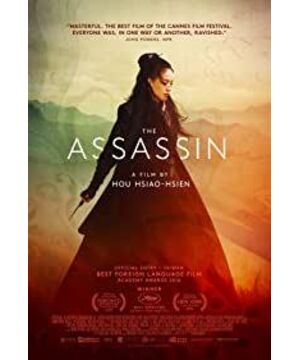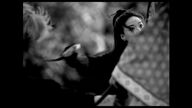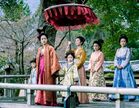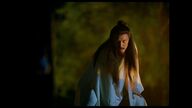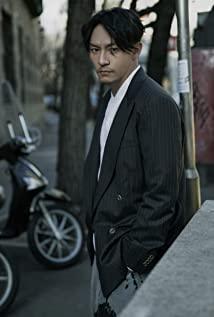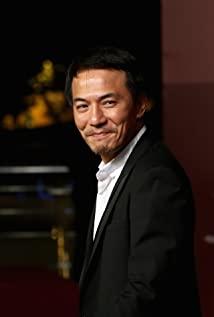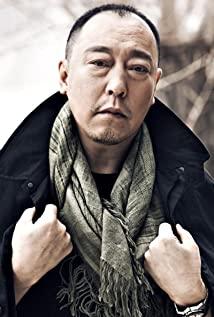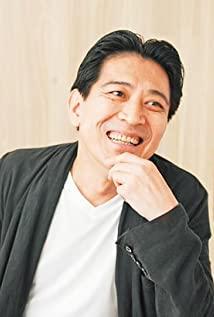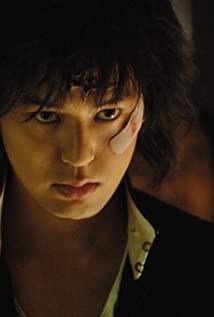1. The story is very simple, not the point, the natural element is the biggest protagonist. In the second half, several montage shots can verify this statement, the sequence is "Morning mist—birds galloping away on the lake—roofs with smoke—burning red charcoal—Feilisheng. "The man of fire", the man is last, not because the character is important, but because he is committed to the environment. To sum up, the protagonist takes the following forms: candlesticks, curtains, mist, vegetation.
2. Again: the protagonist is the element of nature, it is everywhere. Many techniques in the film are to mobilize the movement of natural elements to achieve their goals. 3. In the exterior scene, the wind arrives, the trees and light spots shake, and the sound of the leaves rubbing against each other is highlighted; in the interior scene, the curtains of the front and rear scenes are set, and the middle scene is the smoke produced by sandalwood, and the fog follows the direction of the wind. The sound of the curtains smashing and colliding is also reflected in the sound. It is the display of natural elements, which runs through the whole work. It is worth mentioning that the director who shot the wind so beautifully last time was Akira Kurosawa. Hou Hsiao-hsien once again showed his unique naturalistic tendencies in his creations.
4. Hou Hsiao-hsien actually used Steadicam. In the section where everyone held torches and entered Shennongjia, the tolerance of the picture here cannot be better.
5. The use of cool and warm colors in Li Pingbin's photography is too discriminatory. The interior scene of the Red Balloon Tour with natural light is used in many places in this work. Opening: The contrast between the warm color in the palace and the cold twilight outside the curtain, the middle part: the warm color of the candlelight on the stone at night and the stone soaked in water on the other side, the contrast between the warm and cold under the rendering of the moonlight, the ending: Yu Hou In the wounded house, cold tones invaded from the windows, and the charcoal of the fire in the room was almost burned out.
6. The full use of the three performance areas, the correspondence between the front and back scenes: the characters in the middle scene do not move, and the front and rear scenes are used as curtains and lamps. When the high tolerance allows, the overlapping of the curtains forms a mask, and the characters gradually disappear. ; The erratic candlelight serves more "protagonist" natural elements. At the end, the originality is: the camera uses the spider web as the foreground mask, the spider silk reflection, the little gold thread, the beauty is incredible.
7. The house design is angular, like the tatami lens in Japanese movies, but the angle of the lens is raised to the waist of the character. The placement of candlesticks and tables follows the vertical and horizontal direction of the house.
8. Hou Hsiao-hsien canceled the narrative of the space outside the painting, and the sense of rhythm of the camera shot has been accelerated compared with the previous works; due to the change of the frame, the camera lens has been shaken, and it is still not necessary to push and pull.
9. The movement of the characters is mostly sub-type, or skimming type, to effectively increase the depth of the picture. In the white woods, Nie Yinniang and Kong Konger fought and parted ways. The photography used a deep focus lens to compress the picture, so that the characters' original skimming movements appeared more like parallel lines. Finally, the two merged into the white woods.
10. The martial arts segment is still derived from the typical front and back fights. What has changed is that the camera has been pulled away, but recently it was only a medium shot. In motion capture, the killing action of the characters is hidden and replaced with sound effects. After that, the gaze between the characters is added to make the direct violence turn into continuous force.
11. Director Hou said that Qinggong's action design originated from parkour.
12. In an interview with the main actors, Ruan Jingtian said that Hou Hsiao-hsien's layout on the set was very exquisite, and it was infinitely close to the real environment described in the script, and it was easy for the actors to fall into it. In the process of filming, Hou Hsiao-hsien didn't even call cards, and the play continued so naturally.
13. Similar to Sunglasses' "The Grandmaster", this is a film with a very playful director, and its results in the theater are likely to be the same. It doesn't matter. Great works are basically the director behind the audience's back. Played slowly. It is a lifetime blessing for us to see such a work in theaters.
This is my direct impression of the first brush, and the notes of the second brush are placed below. 1. A short biography about Yin Niang 1, a bird strikes, two shots are for Shu Qi, and one is for the victim, the horse is startled, gallops away, the woods rustle, and the spot of light keeps moving, symbolizing the passing of life.
2. There is a short biography about Yinniang 2, the failure of the assassination mission, the premise is the dialogue between the father and the son, the content is the discussion of life, related to sports, the child pointed at the butterfly and asked two questions, "Why does it fly?" "He Fang"'s father "playing Ju" is all related to the movement of life, vigorous vitality, cleanliness, Yinniang does not kill.
3. The only two slow-moving scenes in the movie, one is Yinniang asking the Taoist girl for guilt, and the other is her adoptive father's helpless assassination mission. Even the characters before the camera stop are in the same position: the Taoist girl and her apprentice face each other, Marquis Nie Yu confronted Madam Yu. In these clips, the elders meant to impose their will on the younger generation. It was teaching or resentment, but it had nothing to do with Yinniang's own wishes.
4. When Yin Niang came back to take a bath, the smoke of sandalwood in the foreground and the mist of hot water in the bathtub were intentionally separated. There was no metaphor, but the depth of the picture was immediately reflected.
5. Only Yin Niang recalled a paragraph, the frame changed to "normal" 1.85:1, the princess told the story of "Qingluan looking in the mirror", except for the opening 1.35:1, the other remained unchanged at 1.41:1. , the role is to render the beautiful situation of the memory.
The narrow frame of 6.1.41:1 is indeed suitable for photographing ancient times, like classical landscape paintings. The movement of horses and carriages in the painting sometimes reminds people of Akira Kurosawa.
7. Tian Yuanshi and Yaoqi (Yinniang) did not meet on formal occasions because of their different identities.
8. Tian Ji'an was furious, dismissed Tian Xing, smashed the dragon seal, and the camera shook. It is very rare to use such "modern" photography techniques in Hou Hsiao-hsien's films.
9. Before Jingjinger's official debut, the camera shot the ancient tree ring in the sky, and then Jingjinger went from left to right without saying a word. Once again, the characters are committed to the environment.
10. Tian Ji's An Xing Lin Hu Ji used a telephoto lens and arranged three performance areas. The candlelight is in the front, and the flickering of the candlelight serves as the foreground. The front, middle and back scenes are simply separated. After the curtain enters the picture, the candlelight and the curtain are integrated. The space for the actors in the middle shot is erased. The importance of consciously blurring the characters in the scene fits together.
11. On the roof at night, Tian Ji'an and Yinniang met. The fight scene was really ugly. The two joined together at the end and deliberately did frame drop processing, but the effect was not satisfactory. It seemed like superfluous. Hu Ji said: For the sake of the seven injustices, Yin Niang was here, Hu Ji officially formed a bond with Yin Niang, and in the future, Yin Niang rescued Hu Ji, not only because she was pregnant, but also because of this aspect.
12. Clothing: Tian Ji'an wears golden clothes with a pure white coat inside. The candlelight provides a red light source, which makes the white underwear play a buffering role. The emperor's entire body is surrounded by different degrees of gold, not only , use the arranged red circles on the back to reconcile, dark red attracts gold, highlighting the noble's weapon, Nie Yuhou often used black and red, in addition to showing his identity, there is also the meaning of forbearance, Yuanshi is the whole Black, in the tug-of-war of various forces, they are the ones who hide the deepest.
13. Tian Xing was demoted and was about to leave. Tian Ji'an specially found Tian Yuanshi and told him that the burial could not happen again. It was a warning. Tian Yuanshi inquired about Yinniang's news, but Tian Ji'an avoided it with praise, which was a mockery.
14. The old man Kong Konger made his first appearance. He first focused on the landscape painting on the wooden boards behind him. In the painting, most of the space was occupied by the mist lingering at the foot of the mountain, which revealed Kong Konger's art very well.
15. Yinniang met the mirror-maker by chance and told him the story of Qingluan dancing, not because she wanted to compare herself to a phoenix, but because she knew from the mirror-maker that she was not with Princess Jiaxing and Jiacheng. Such a phoenix. She doesn't want to be a recluse from the world, and she can't. She wants to be a traveling knight like a mirror-maker.
16. The mist flowed by the river, the geese left on the water mirror, the green smoke rose from the eaves, the animals screamed, the mirror-making boy suddenly got up, calmed down, made a fire, and Father Nie fell asleep. Feeling the surrounding nature, this is why Yin Niang is willing to follow him.
17. The duel between Jingjinger and Yinniang was given to the branches and white clouds, and it was included in the close-up of the two characters, which means that in this duel, they acted as the audience.
18. Tian Ji'an and Hu Ji dance, and the maid rotates around them, serving as the front and back of the photo. Because the telephoto lens is still used, its focal length is only on the center performance area, and the maid's skirt is constantly rotating, blurring into a piece , like a constantly flowing tassel, revolving around the two, just to look good.
19. Tian Ji'an drew a knife against Tian Yuanshi, not only because she wanted to poison Hu Ji, who was pregnant, but also because the death of her late father was inseparable from Tian Yuanshi. Hou Hsiao-hsien said that originally, Tian Ji'an could stop when he left, but Hou Hsiao-hsien let the tape go on, and Zhou Yun's improvisation was perfect.
20. After the assassination failed, Yinniang and the Taoist nun were on the top of the mountain, and the place where the Taoist nun stood was withered and yellow. Then, the fog changed, covering the background, and the Taoist nun was blurred, which led to her murderous intention.
21. Taoist nun and Yinniang are walking on the same road, but there is a tree that has already dried up in the middle, which means the break between the two.
22. Aries lay there in twos and threes outside the village, calm and relaxed, Yinniang came to the village, the mirror-making boy was very happy, and went on the road, but, this time, not only Yinniang is alone, like Aries, in groups, Not Phoenix.
View more about The Assassin reviews


